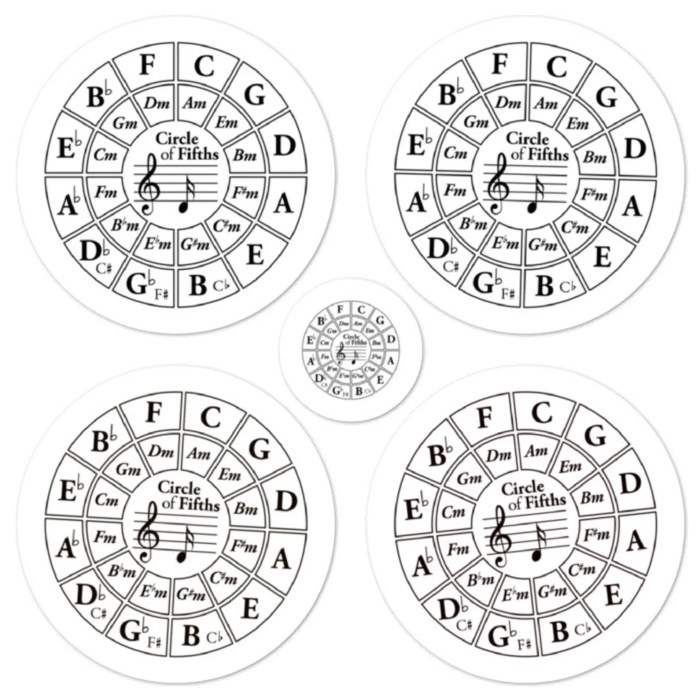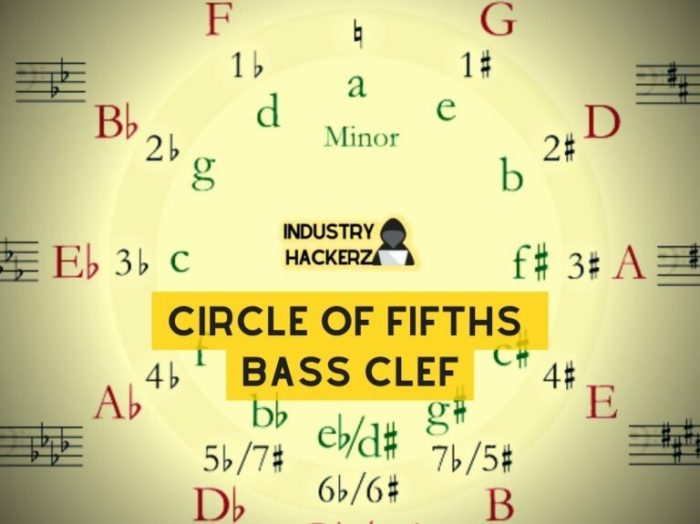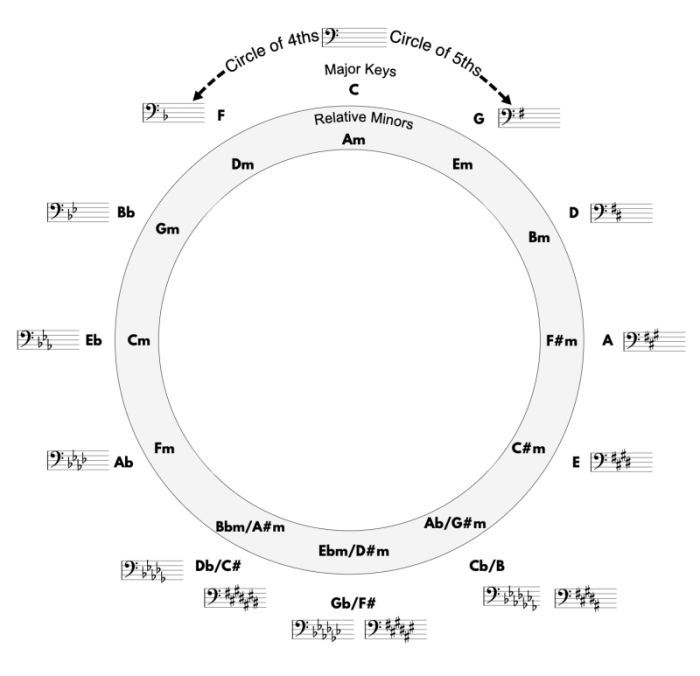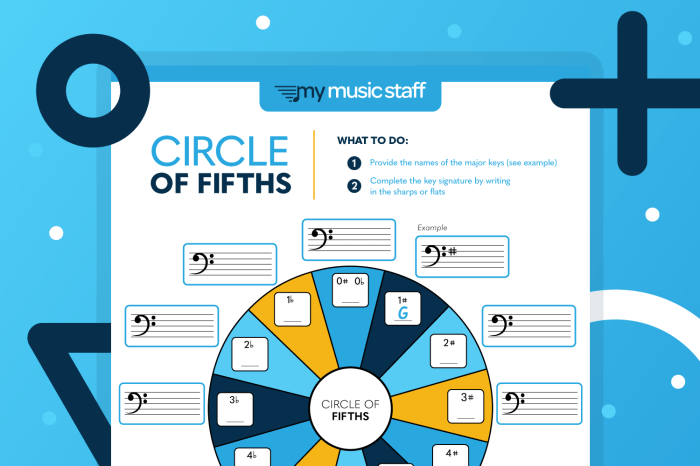Embark on a musical odyssey with the bass clef circle of fifths, a fundamental concept that unlocks the secrets of harmony and melodic construction. This intricate system provides a roadmap for navigating the musical landscape, revealing the relationships between notes, scales, and chords.
The circle of fifths is a visual representation of the musical alphabet, arranged in a clockwise sequence. Each step around the circle represents an upward movement of a perfect fifth interval, the building block of Western music. The bass clef, responsible for the lower-pitched notes, plays a crucial role in understanding this system, as it provides the foundation for constructing chords and melodies.
Circle of Fifths

The circle of fifths is a diagram that represents the relationship between the 12 musical notes in the Western musical system. It is arranged in a circle, with each note connected to the next by a fifth interval.The circle of fifths is a useful tool for understanding the relationships between different keys and chords.
It can also be used to help you memorize the order of the sharps and flats in each key signature.
Relationship to Bass Clef
The circle of fifths is particularly useful for understanding the bass clef. The bass clef is used to write notes that are lower in pitch than the treble clef. The notes in the bass clef are arranged in the same order as the notes in the circle of fifths, with the lowest note on the bottom line and the highest note on the top line.
Key Signatures and the Circle of Fifths

The circle of fifths is a visual representation of the relationship between musical keys. It can be used to derive key signatures, which are the sharps or flats that are added to the staff to indicate the key of a piece of music.
To derive a key signature from the circle of fifths, start at the key of C major (no sharps or flats) and move clockwise around the circle. Each step you take represents adding one sharp to the key signature. For example, the key of G major has one sharp (F#), the key of D major has two sharps (F# and C#), and so on.
Conversely, if you move counterclockwise around the circle, you are adding flats to the key signature. For example, the key of F major has one flat (Bb), the key of Bb major has two flats (Bb and Eb), and so on.
Examples of Key Signatures and Their Positions on the Circle of Fifths
- C major (no sharps or flats) – at the top of the circle
- G major (one sharp) – one step clockwise from C
- D major (two sharps) – two steps clockwise from C
- A major (three sharps) – three steps clockwise from C
- E major (four sharps) – four steps clockwise from C
- B major (five sharps) – five steps clockwise from C
- F# major (six sharps) – six steps clockwise from C
- C# major (seven sharps) – seven steps clockwise from C
- F major (one flat) – one step counterclockwise from C
- Bb major (two flats) – two steps counterclockwise from C
- Eb major (three flats) – three steps counterclockwise from C
- Ab major (four flats) – four steps counterclockwise from C
- Db major (five flats) – five steps counterclockwise from C
- Gb major (six flats) – six steps counterclockwise from C
- Cb major (seven flats) – seven steps counterclockwise from C
Bass Clef Notes and the Circle of Fifths

The bass clef is used to write notes in the lower register, typically for instruments like the cello, bassoon, and trombone. The notes in the bass clef are arranged in a specific pattern on the staff, and the circle of fifths can be used to help us understand this pattern and find the correct notes.
The bass clef circle of fifths is a handy tool for musicians, but if you’re feeling a bit rusty, you can check out the apes unit 5 practice test to brush up on your knowledge. The test covers a range of topics related to environmental science, including climate change, biodiversity, and energy resources.
After you’ve aced the practice test, you’ll be ready to tackle the bass clef circle of fifths with renewed confidence.
The circle of fifths is a diagram that shows the relationship between the twelve notes of the chromatic scale. The circle is arranged in a clockwise direction, with each note being a perfect fifth above the previous one. The notes are also grouped into seven major keys, with each key starting on a different note of the circle.
Bass Clef Notes on the Circle of Fifths, Bass clef circle of fifths
The notes in the bass clef are arranged in the following order, starting from the bottom line and moving up:
- G
- B
- D
- F
- A
The circle of fifths can be used to find the correct notes in the bass clef by starting on the note G and moving clockwise around the circle. For example, the note next to G is C, and the note next to C is F.
This tells us that the notes in the bass clef are G, B, D, F, and A.
Scales and the Circle of Fifths

The circle of fifths is a powerful tool for understanding scales. It can be used to construct scales, identify key signatures, and determine the relationship between different scales.The circle of fifths is a diagram that shows the relationship between the 12 notes of the chromatic scale.
The notes are arranged in a circle, with each note connected to the next by a fifth. For example, C is connected to G, G is connected to D, and so on.The circle of fifths can be used to construct scales by starting on any note and moving around the circle in fifths.
For example, to construct the C major scale, we start on C and move around the circle in fifths: C, G, D, A, E, B, F#, C.The circle of fifths can also be used to identify key signatures. The key signature of a piece of music tells us which notes are sharp or flat.
The key signature is determined by the last note in the circle of fifths that is not sharp or flat. For example, the key signature of C major is no sharps or flats, because C is the last note in the circle of fifths that is not sharp or flat.The
circle of fifths is a valuable tool for understanding scales and key signatures. It is a simple diagram that can be used to construct scales, identify key signatures, and determine the relationship between different scales.
Chord Progressions and the Circle of Fifths: Bass Clef Circle Of Fifths

The circle of fifths can be a powerful tool for creating chord progressions. By moving around the circle in either direction, you can create progressions that sound smooth and natural.One of the most common chord progressions is the I-IV-V progression.
This progression starts on the tonic chord (I), moves to the subdominant chord (IV), and then to the dominant chord (V). This progression can be used in any key, and it always sounds great.Another common chord progression is the I-vi-IV-V progression.
This progression is similar to the I-IV-V progression, but it adds a vi chord in between the IV and V chords. This progression can create a more complex and interesting sound.The circle of fifths can also be used to create more complex chord progressions.
For example, you can use the circle to create progressions that move through multiple keys. You can also use the circle to create progressions that use diminished or augmented chords.The possibilities are endless when it comes to using the circle of fifths to create chord progressions.
Experiment with different progressions and see what you can come up with.
Examples of Chord Progressions
Here are some examples of chord progressions that utilize the circle of fifths:* I-IV-V (C-F-G)
- I-vi-IV-V (C-Am-F-G)
- I-V-vi-IV (C-G-Am-F)
- I-IV-I-V (C-F-C-G)
- I-vi-IV-V-I (C-Am-F-G-C)
These are just a few examples of the many chord progressions that can be created using the circle of fifths. Experiment with different progressions and see what you can come up with!
FAQ Summary
What is the significance of the bass clef in the circle of fifths?
The bass clef provides the foundation for constructing chords and melodies, as it represents the lower-pitched notes. Understanding the relationship between the bass clef and the circle of fifths allows musicians to determine the correct notes and intervals.
How can the circle of fifths be used to create chord progressions?
The circle of fifths provides a roadmap for creating chord progressions by showing the relationships between different chords. By moving around the circle, musicians can easily identify chords that sound harmonious together.
What is the role of scales in the circle of fifths?
Scales are closely related to the circle of fifths, as they are constructed using specific intervals. The circle of fifths can be used to determine the notes that make up a particular scale and to understand the relationships between different scales.